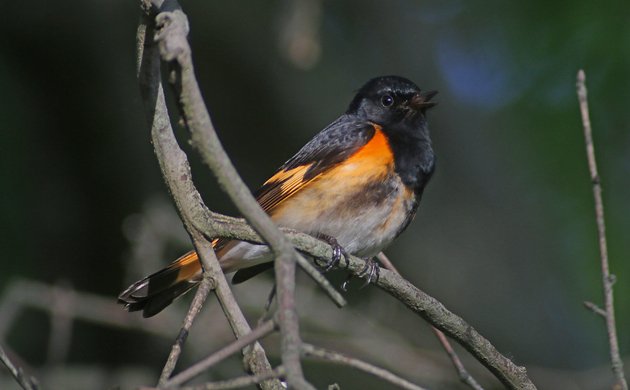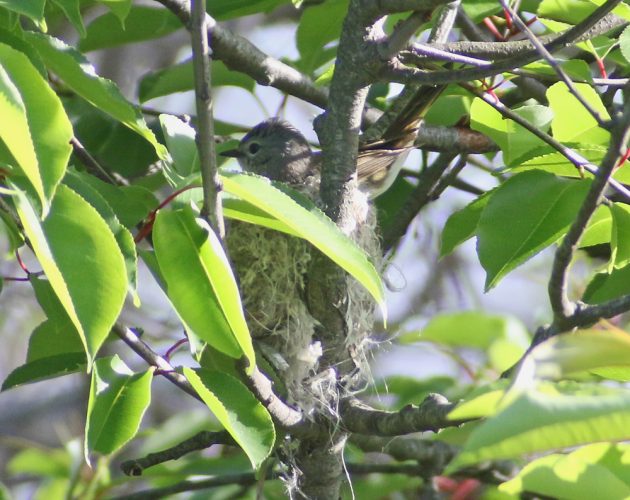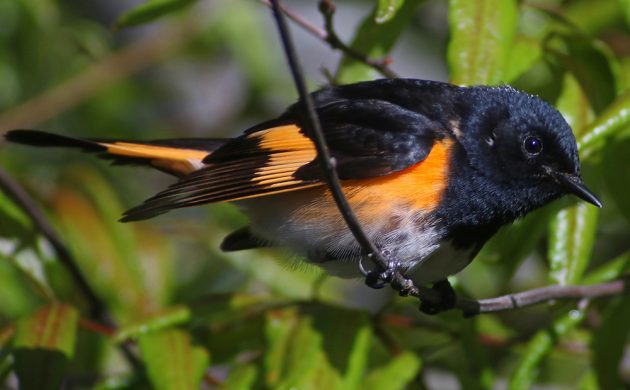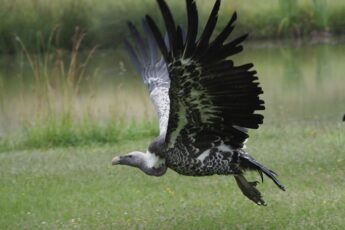
I’ve lived in Queens for eight years now and have visited Jamaica Bay Wildlife Refuge over one hundred times while I’ve been here. Every spring American Redstarts get back to Jamaica Bay and set up territories and I’ve never failed to learn exactly where those territories are. But despite my hard-earned knowledge I’ve never managed to figure out exactly where they hide their nests. Well, that is, I never found one of their nests until Sunday, 21 May, when I happened to notice a female redstart carrying some nesting material.
female American Redstart working on her nest at Jamaica Bay Wildlife Refuge
She was industrious, returning to the nest site every minute or two, quickly adding some soft material as nest lining and taking off again. I couldn’t see exactly where she was going to gather the material so I’m not sure exactly what it was.
Just as with the hummingbird nest which I digiscoped on the same day I made my observations from the trail as I neither wanted to trample habitat nor disturb the bird. Jamaica Bay is a very busy refuge and it’s important that visitors stick to the trails and do their best not to disturb the wildlife. Our wild birds have enough to deal with and they shouldn’t have to suffer from humans acting stupidly.
I believe that the male at the top of this post and below is the mate of the bird working on the nest. He was vigilant, singing regularly to show it was his territory, as she worked diligently on the nest. Here’s hoping they fend off predators, cowbirds, the weather, and everything else that can negatively impact nesting songbirds and successfully fledge some redstarts!
…






 New writers welcome – please contact us for details.
New writers welcome – please contact us for details.

















At last, I found that bird! I was recently in NY to accompany my father to a few doctor’s appointments. He’s aging, has cataracts, recovering from COVID induced blood-sugar spike causing him to require insulin. I decided, that since the weather was a bit warmer than it was just a few weeks prior when I visited him, I would bring a couple of DSLRs, 2 long lenses, a tripod, and a backpack that included water, a portable stool, and head over to Jamaica Bay. I’ve never been there, though have driven past it many times over the years, never realizing what it was.
I searched for locations close to where he resides and Queens and decided this was the only place that I thought would guarantee at least a few shots. I was not disappointed. The Yellow Warblers were nesting and flying about, zipping back and forth. Then as I was nearing the welcome center, spotted this little guy just 10 feet away from me. He and I managed to shoot at least a dozen good shots before he went deeper into the brush and until now I have been stumped on the species until I came across your article from 2017.
Nice work, great article.